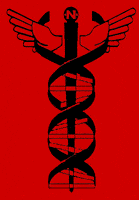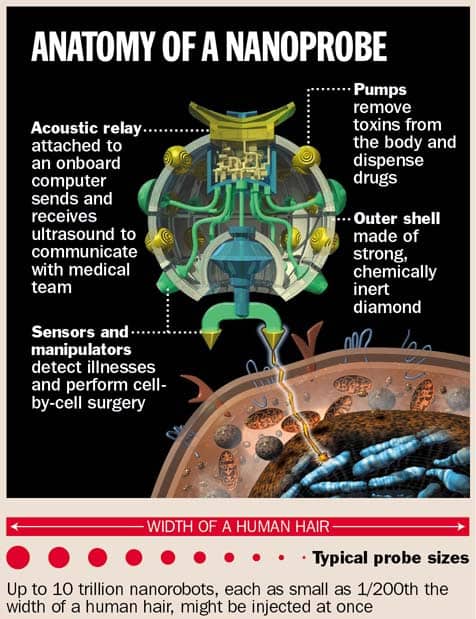

Anatomy of a Nanoprobe
1999
476 X 619 pixels
Color
Imagine an army of tiny robots, each no bigger than a bacterium, swimming through your bloodstream. One platoon takes continuous readings of blood pressure in different parts of your body; another monitors cholesterol; still others measure blood sugar, hormone levels, incipient arterial blockages and immune-system activity.
Such are the dreams of the nanotechnologists, engineers at places like M.I.T., Princeton University and Carnegie Mellon, who are already redefining the meaning of the word miniature. The prefix nano- refers to a billionth part of a unit — the size range these visionaries are talking about. Already, nanotechnologists have built gears and rotors far thinner than a human hair and tiny molecular “motors” only 50 atoms long.
But that’s just the beginning. Within a few decades, nanotechnologists predict, they will be creating machines that can do just about anything, as long as it’s small. Germ-size robots will not just measure internal vital signs; they will also organize the data with molecular microcomputers and broadcast the results to a mainframe (implanted under your skin, perhaps), where the data can be analyzed for signs of disease. Nanomachines could then be sent to scour the arteries clean of dangerous plaque buildup, or aid the immune system in mopping up stray cancer cells, or even, a la Fantastic Voyage, vaporize blood clots with tiny lasers.
If the nanotech guys are right, a call to the family doctor a few decades from now could yield a high-tech variation on an old cliche: “Take two teaspoons of diagnostic sensors, and call me in the morning.”
Image labels, clockwise from top right:
“Pumps remove toxins from the body and dispense drugs.”
“Outer shell made of strong, chemically inert diamond.”
“Sensors and manipulators detect illnesses and perform cell-by-cell surgery.”
“Acoustic relay attached to an onboard computer sends and receives ultrasound to communicate with medical team.”
Caption at bottom: “Physical probe sizes. Up to 10 trillion nanorobots, each as small as 1/200th the width of a human hair, might be injected at once.”
© Copyright 1999 by Time Magazine, Time & Life Building, Rockefeller Center, New York, NY 10020-1393. For reprint permission, please contact Michael D. Lemonick, staff writer, Time Magazine, or the artwork reprint rights department at Time Magazine, Inc., Tel. 212-522-1779, email: [email protected]., URL: http://time.com/
Michael D. Lemonick, “…And Will They Go Inside Us? Given the Promise of Nanotechnology, It’s a Safe Bet,” Time Magazine 154 (8 November 1999):93.
None.
